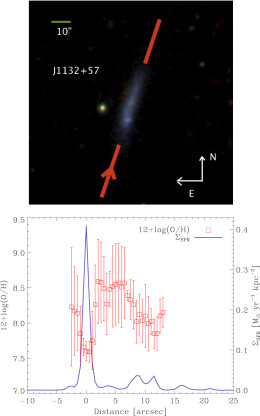Scientists have recently identified a connection between metal-poor regions in a set of dwarf galaxies and bursts of star-formation activity within them. These observations provide long-awaited evidence supporting predictions of how stars formed in the early universe and in dwarf galaxies today.
Metal-Poor Clues
The primary driver of star formation over cosmic history is thought to be the accretion onto galaxies of cold gas streaming from the cosmic web. The best way to confirm this model would be to observe a cloud of cosmic gas flowing into an otherwise-quiescent galaxy and launching a wave of star formation. But because cold gas doesn’t emit much radiation, it’s difficult to detect directly.
Now, a team of scientists have found a clever way around this problem: they searched galaxies for a correlation between areas of active star formation and metal-poor regions. Why? Because metal-poor regions could be a smoking gun indicating a recently accreted cloud of cold gas from the cosmic web.
Impacting Clouds

Distribution of metallicity along the major axis of one of the target galaxies. The red bar in the top image shows the position of the spectrograph slit along the galaxy, with the arrow showing the direction of growing distance in the plot below. The plot shows the metallicity variation (red symbols) and star-formation rate (blue line) along the galaxy’s major axis. The metallicity drop coincides with the brightest knot of the galaxy. [Sánchez Almeida et al. 2015]
The team found that, in nine out of the ten cases, the galaxies displayed sharp drops (by factors of 3–10) in metallicity along a portion of their lengths. The metallicity drops corresponded to bright knots representing starburst regions, in which surface star formation rates are larger than that of the rest of the galaxy by factors of 10–100.
The authors conclude that in these galaxies, a cold cosmic gas cloud with low metallicity impacted the galaxy’s outer region. This impact caused the cloud to compress, triggering the star formation we now observe. At the same time, the gas from the cloud diluted the region’s metallicity, resulting in the low abundances now measured. The authors determine that the cloud impacted within the last 100 Myr — otherwise enough time would have passed for the gas to mix azimuthally as it rotated around the galaxy.
Citation
J. Sánchez Almeida et al 2015 ApJ 810 L15. doi:10.1088/2041-8205/810/2/L15

9 Comments
Pingback: details of low metal star formation from newly captured gas
Pingback: ¿Cómo se alimenta una galaxia? | canarias3puntocero
Pingback: Logran observar cómo se alimenta una galaxia | Noticias de León Diario Digital
Pingback: ¿De qué se alimenta una galaxia? | LAKLAVE
Pingback: Reporte Ciencia UANL Logran observar cómo se alimenta una galaxia - Reporte Ciencia UANL
Pingback: Logran observar cómo se alimenta una galaxia - Sociedad 3.0
Pingback: Logran observar cómo se alimenta una galaxia – Civico
Pingback: Logran observar cómo se alimenta una galaxia – Civico
Pingback: Logran observar cómo se alimenta una galaxia | Civico